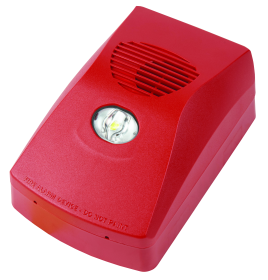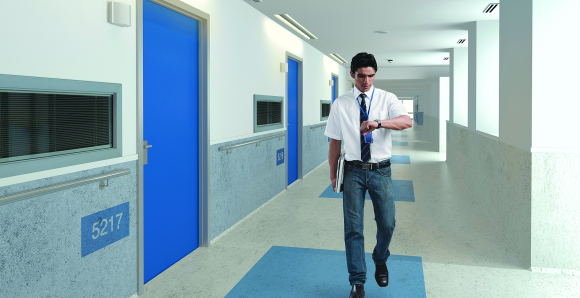

In the event of a fire, saving lives is the highest priority. Building occupants need to be alerted as early as possible using alarm devices, so they can evacuate quickly. It is a mandatory requirement for audio alarms to be used as an integral part of the fire detection and alarm system. Visual alarm devices (VADs) are used to supplement audio, providing an effective means of alerting and evacuating occupants.
EN54-23 standard for visual alarm devices
The installation of VADs has been mandatory since January 2014 and with the introduction of EN54-23 the use of VADs has grown considerably. The recent release of EN54-23 by the European Committee for Standardization (CEN) clarifies the use of visual alarm devices in fire detection and alarm systems for non-domestic premises.
EN54-23 provides clarity by standardising requirements, test methods and performance criteria of VADs and ensures all device parameters are measured in a uniform manner. Prior to its release, misinterpretation and confusion over a particular product’s performance was a common concern in the industry, since there was no EN standard in existence for VADs.
Where visual alarm devices are needed
Regulations and codes recommend that VADs should be installed in places where audible devices alone would be ineffective or where they are simply undesirable. Typical applications where VADs should
be installed are areas with hearing impaired people, hospitals or sleeping areas like hotels, public assembly buildings, broadcasting studios, manufacturing sites or where people wear hearing protection due to high ambient-level noise.

Requirements for VADs
There are four main requirements each VAD needs to achieve to be compliant with EN54-23. First is the illumination level, with a minimum of 0,4 lux in the area covered by the device. Second is the flash rate, which should be set at 0,5 Hz to 2 Hz.
Flash colour is the third consideration and is dependent on how the evacuation criteria are defined. Red or white light can be used for a single-stage evacuation, while amber may be used for the first stage in a multi-stage evacuation process. Keep in mind that white light requires higher power consumption than other colours, which should be taken into consideration when the fire alarm system is designed.
The fourth criterion is the installation category, which refers to the area illuminated by the VADs. These are mainly classified by wall category, ceiling category and open class category. There is also a distinction between devices for indoor and outdoor use.
The coverage volume that can be achieved with VADs today has increased due to advancements in technology. Depending on the category, the diameter of coverage ranges between 7,5 metres and 15 metres. This means fewer devices are required to reach the same exposure.
Faster evacuation with shorter pulse length
In addition to alerting occupants as early as possible, it is important to quickly foster a reaction so they understand they must leave the building immediately. Independent laboratory tests show the way people react to a VAD is influenced by the duration of the pulse. Interestingly, the shorter the pulse duration, the faster the reaction. Consequently, shorter pulse durations of LED VADs will result in improved attention from occupants.
Regular testing of fire detection systems is necessary but often disruptive, especially in buildings such as hospitals or hotels. The latest VADs available offer automatic self-test features which minimise disruption during testing.
Automatic self-tests can be scheduled at any time and the test duration is typically less than 1 second per device, so there is virtually no disruption to occupants. Additionally, accuracy is high as the system monitors real physical outputs and not just electrical simulations.
VADs offer a fast and effective way to alert and evacuate people during an emergency. Environmental conditions, ambient light levels and other factors determine the type and specification of the devices required. Therefore, it’s advisable to carry out a fire risk assessment of the area before applying any system design. This will maximise the effectiveness of the system and increase the potential to save lives.
Anja Schäfers joined Johnson Controls in 2012 and has more than 7 years of experience in the fire industry. She holds the position of a product marketing manager for the EMEA region and supports both the FireClass and ZETTLER fire detection product portfolios. Anja earned her Master’s degree of business administration and is based out of the Johnson Controls office in Munich, Germany.
For more information, contact Shane Payne, Johnson Controls, +27 11 011 4069, [email protected], www.johnsoncontrols.com
| Tel: | +27 11 921 7100 |
| Email: | [email protected] |
| www: | www.johnsoncontrols.co.za |
| Articles: | More information and articles about Johnson Controls |

© Technews Publishing (Pty) Ltd. | All Rights Reserved.